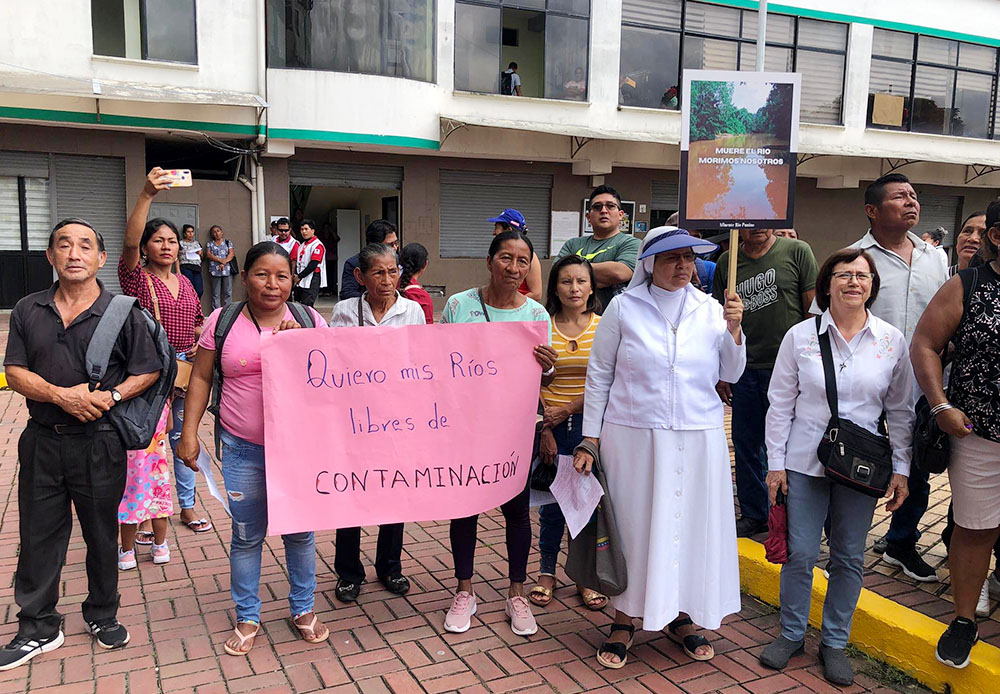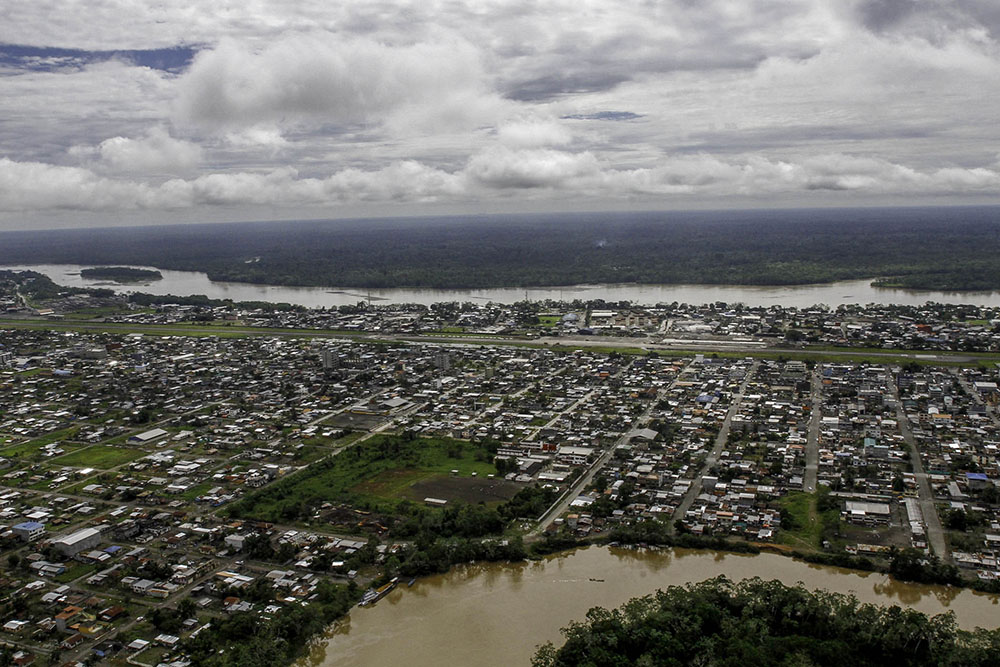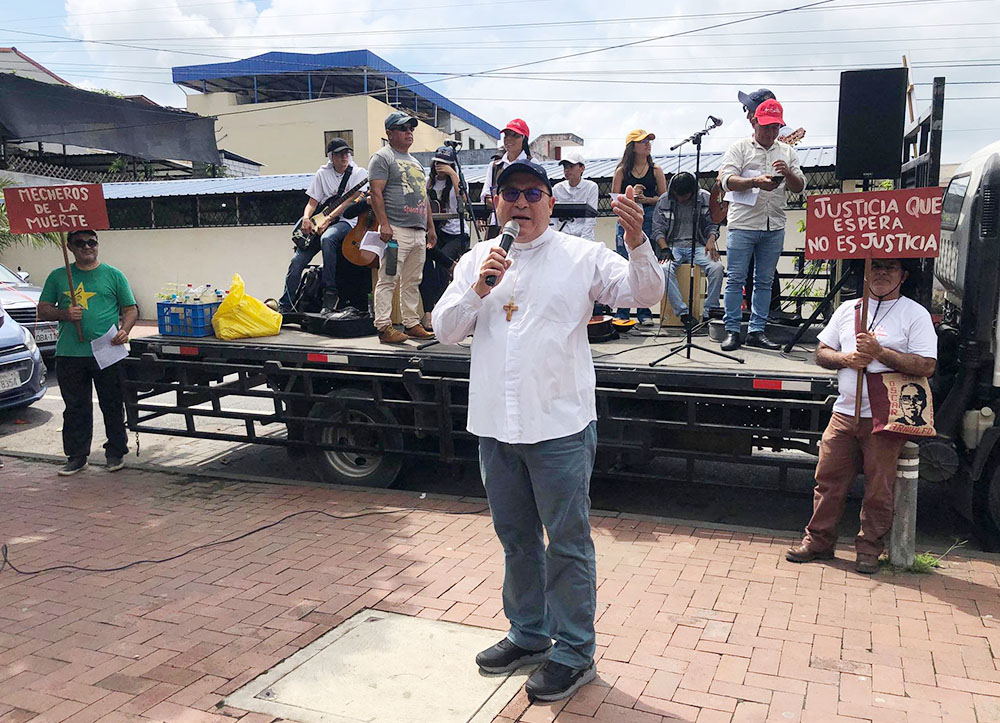
In March in Puerto Francisco de Orellana, Ecuador, activists protest mining and oil exploitation in the rainforest. (Courtesy of Aguarico Vicariate)
Church activists from the province of Orellana in the Ecuadorian Amazon have been staging weekly protests since February against mining and oil exploitation in the rainforest. Protesters say extraction activities are contaminating the local rivers, soil and atmosphere and are linked to dozens of cases of cancer in the region.
Every Monday between 4:00-5:00 p.m., a group of community organizers and members of the clergy has been gathering in front of the prosecutor's office in Puerto Francisco de Orellana, the province's capital city, also known as El Coca. They demand the immediate interruption of illegal mining operations in the zone.
"Large-scale mining endeavors are something new in Orellana. During the COVID-19 pandemic, illegal miners opened roads in the forest and brought heavy machines. We counted at least 200 backhoes," Bishop José Adalberto Jiménez of the Aguarico Vicariate told EarthBeat.
Jiménez, who heads the Pan-Amazon Ecclesial Network (known as REPAM) in Ecuador, explained that the demonstrators do not form a large group, but they want to gradually reach more people and raise awareness on the seriousness of the social and environmental impacts of illegal mining.
"The Punino and Payamino rivers are contaminated with heavy metals used by miners, like mercury. They are the source of the water we use in the region. People are getting sick," he said.

The Payamino River is seen in the foreground and the Coca River in the background of a 2015 aerial photo of Puerto Francisco de Orellana, Ecuador. (Wikimedia Commons/Agencia de Noticias ANDES)
Carlos Azcona, a Spanish-born lay missionary who works in the vicariate, affirmed that many backhoes are positioned in zones with water springs. Those machines also destroy vast portions of land in their operations.
"Those are places of great biodiversity. It is a crime — and we cannot understand why the authorities do not intervene," he told EarthBeat.
Recently, the army raided the mining zones and removed dozens of machines, Jiménez said.
"But after a week or so, they were all back to the forest. We demand that more forceful measures are taken," he added.
The protesters say that criminal organizations are behind mining in Orellana. Indigenous communities, which directly face the effects of the contamination in the region, have been continually visited by masked men who threaten them and force them to collaborate with their operations.
They also suspect that local politicians had their electoral campaigns funded by those criminal organizations that are behind mining in the region — and that some government authorities are the real owners of the machines being used by the illegal miners.
Oil exploitation is a more ancient problem in the region. When drilling began back in the 1980s, the Capuchin friars, who have been leading the mission from the start in 1953, quickly noticed that it had negative impacts on the environment and on the Indigenous communities.
Then-Bishop Alejandro Labaka, a Basque-born missionary among the local Waorani people, accompanied the communities' struggle against the implantation of the oil endeavors in Orellana, and ended up losing his life in the process.
In 1987, Labaka and Capuchin Sr. Inés Arango went to the village of the isolated Tagaeri people, who were being affected by oil exploitation.
"The group mistakenly assumed that they were members of the oil companies and killed them," Jiménez recalled.
Arango and Labaka became martyrs and symbols of the resistance of Orellana's residents to oil exploitation. Every year, Azcona leads a march between Quito and Coca to celebrate their memory in July.
Nevertheless, drilling continued and has caused severe damages over the years, said Jiménez.

Bishop José Adalberto Jiménez speaks in March in Puerto Francisco de Orellana, Ecuador, at a protest against mining and oil exploitation in the rainforest. (Courtesy of Aguarico Vicariate)
"The pipes are not maintained and replaced as they should, so spills are common. In 10 years, there were a thousand occurrences," he said.
In April 2020, a serious incident resulted in the spill of 15,800 barrels of crude on the rivers Coca and Napo. A high mortality of fish and other water species — like anacondas, turtles and Amazon river dolphins — was the first noticeable impact, but other damages are felt now.
"One can see oil spots on the margins. There are deposits on the riverbed as well. Vegetables grown near the river do not produce fruits," Jiménez said.
Less than one year later, a new spill threw 6,300 barrels of crude on the same basin. The vicariate took the case to international courts, but the problems continue.
"There are 447 gas flares burning day and night, contaminating the air, and causing diseases in the people," Azcona said.
The smoke generated by the flares, he argued, is connected to hundreds of cases of cancer in the vicariates of Aguarico and Sucumbios.
In 2020, the church promoted a campaign named ¡Apaguen los mecheros, enciendan la vida! ("Turn off the flares, turn on life!"), which involved a lawsuit filed by nine local girls against the oil company.
"In July 2021, a judge ruled that all flares should be eliminated within 18 months. But nothing has been done. That is why we are tired of all that and declared a permanent state of resistance," Azcona said.
With all such problems, organizing the struggle in Orellana has not been an easy task. Azcona said that the power of the mining and oil companies is so huge that most communities feel weak and defenseless against them.
"Unemployment in the region is high and people end up concluding that those endeavors at least can give them some money," he added. Most communities are divided over the subject.
Darwin Camacho, a community leader in the parish of San José de Guayusa, recalled that most communities were against mining at first.
"They wanted to protect the environment and their territories, so they denounced the projects. But the authorities failed to act, and the economic power corrupted some of them," he told EarthBeat.
Camacho said that most groups living in the area are Quechua. Despite their traditional values, they ended up allowing miners to access their lands.
Advertisement
"They live in poverty, so they preferred to make a deal with the miners. Most of them ignore their rights. Most of their leaders have been cooperating with the devastation," he lamented.
Camacho said that the local rivers, which provide water to the small growers, have a strange, reddish color.
"Those chemicals certainly impact the fauna, the flora and the production of food. About 10 children die in the parish every year due to malnourishment," he said.
Among urban residents, many people do not have information about the environmental problems caused by mining and oil exploitation, said Melany García, who heads the vicariate's Youth Pastoral Ministry.
"The local press and TV stations do not talk about that. When we present those issues to young people during our meetings, they are shocked," she told EarthBeat.
García said that many young Catholics have been marching for the environment and taking part in the weekly protests in El Coca.
"The people involved in the vicariate's activities develop environmental awareness over time," she said.
The church's role in her own life has been fundamental. She chose to study environmental engineering at the university thanks to her experience of six years in the Youth Pastoral Ministry. Pope Francis' Querida Amazonia post-synodal apostolic exhortation was one of the documents her group studied over the past few years.
"My life goal is to take care of the Amazon. Many of my colleagues want to study medicine in order to work for the local communities as well," she said.
Jiménez hopes that more Catholics take part in the struggle in the future.
"My biggest motivation is Pope Francis's messages in Laudato Si'. Many in the church prefer to remain in a more spiritual world, but we are called to take care of our common house," he said.








